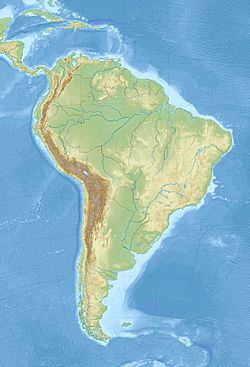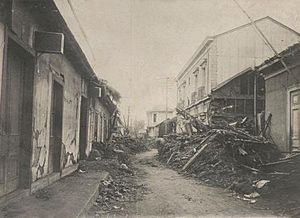1922 Vallenar earthquake facts for kids
| UTC time | 1922-11-11 04:32:51 |
|---|---|
| ISC event | 912062 |
| USGS-ANSS | ComCat |
| Local date | 10 November 1922 |
| Local time | 23:53 |
| Magnitude | 8.5 Mw |
| Depth | 70.0 km (43 mi) |
| Epicenter | 28°30′S 70°00′W / 28.5°S 70.0°W |
| Areas affected | Chile, Argentina |
| Tsunami | Yes |
| Casualties | Several hundred |
The 1922 Vallenar earthquake was a very powerful earthquake. It happened in the Atacama Region of Chile, close to the border with Argentina. The earthquake struck on November 11, 1922, at 4:32 AM UTC. It had a moment magnitude of 8.5, which is extremely strong.
This earthquake also caused a huge and damaging ocean wave, known as a tsunami. The tsunami hit the coast of Chile very hard. Its effects were even noticed in faraway places like Australia.
Contents
Why Did the Earthquake Happen?
The 1922 Vallenar earthquake happened because of how Earth's giant plates move. Our planet's outer layer is made of huge pieces called tectonic plates. This earthquake occurred where the Nazca Plate and the South American Plate meet. These two plates are constantly moving towards each other, or converging, at about 70 millimeters (about 2.7 inches) each year.
Chile is located right on this busy plate boundary. Because of this, it often experiences very strong earthquakes called megathrust earthquakes. These powerful quakes have been happening in Chile for a very long time, over 500 million years! In fact, the strongest earthquake ever recorded, the Great Chilean Earthquake, also happened along this coast. More recently, in 2010, another part of this plate boundary ruptured in central Chile.
What Happened During the Earthquake?
The Ground Shaking
Before the main earthquake, there were smaller earthquakes called foreshocks. These happened on November 3 and November 7. The main earthquake itself lasted for different amounts of time, with reports saying it shook the ground for anywhere from 30 seconds to eight minutes.
Scientists estimate that the part of the plate boundary that broke during this earthquake was about 390 kilometers (242 miles) long. This shows just how big the event was.
The Tsunami Waves
The earthquake's starting point, called the epicenter, was actually inland, not directly under the ocean. So, the tsunami might not have been caused directly by the earthquake shaking the seafloor. Instead, it might have been caused by a huge underwater landslide, or submarine slide, that was triggered by the strong shaking.
The tsunami hit different coastal towns at different times and with different strengths:
- At Caldera, the tsunami arrived about 15 minutes after the earthquake. The highest wave reached about 7 meters (23 feet) up the land.
- At Chañaral, the tsunami came in three big waves, or surges. The first wave arrived about an hour after the earthquake. The biggest wave reached an amazing 9 meters (30 feet) high!
- Coquimbo also saw three surges. The last one was the most destructive, with waves reaching about 7 meters (23 feet).
The tsunami waves traveled across the entire Pacific Ocean! They were observed in many distant places, though they were much smaller there:
- Callao, Peru: 2.4 meters (7.9 feet)
- California: 0.2 meters (8 inches), arriving 13 hours later
- Hawaii: 2.1 meters (6.9 feet), arriving 14.5 hours later
- Samoa: 0.9 meters (3 feet), arriving 14.1 hours later
- Japan: 0.3 meters (1 foot)
- Taiwan: 0.03 meters (1 inch)
- New Zealand: 0.1 meters (3.9 inches)
- Australia: 0.2 meters (7.9 inches)
- Philippines: 0.1 meters (3.9 inches)
See also
 In Spanish: Terremoto de Vallenar de 1922 para niños
In Spanish: Terremoto de Vallenar de 1922 para niños



